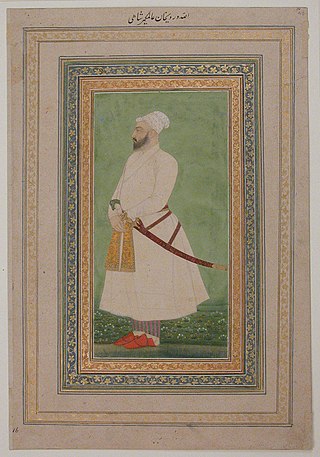
Awadh, known in British historical texts as Avadh or Oudh, is a historical region in northern India, now constituting the northeastern portion of Uttar Pradesh. It is roughly synonymous with the ancient Kosala region of Hindu, Buddhist, and Jain scriptures.

Shuja-ud-Daula was the Subedar and Nawab of Oudh and the Vizier of Delhi from 5 October 1754 to 26 January 1775.

Rohillas are a mixed Indian community of Pashtun heritage, historically found in Rohilkhand, a region in the state of Uttar Pradesh, India. It forms the largest Pashtun diaspora community in India, and has given its name to the Rohilkhand region. The Rohilla military chiefs settled in this region of northern India in the 1720s, the first of whom was Ali Mohammed Khan.

Mir Syed Jafar Ali Khan Bahadur was a commander-in-chief or military general who reigned as the first dependent Nawab of Bengal of the British East India Company. His reign has been considered by many historians as the start of the expansion of British control of the Indian subcontinent in Indian history and a key step in the eventual British domination of vast areas of pre-partition India.

Mirza Asaf-ud-Daula was the Nawab wazir of Oudh ratified by Shah Alam II, from 26 January 1775 to 21 September 1797, and the son of Shuja-ud-Dowlah. His mother and grandmother were the Begums of Oudh.
Sayyid Dildar 'Ali, also known as Ghufran-Ma'ab Naseerabadi, was a Shia scholar of India, from the village of Nasirabad, Raibareli in Uttar Pradesh, India. His best-known work is "Imad-ul-Islâm", in Arabic, a refutation of the anti-Shia arguments used by the famous Fakhr al-Din al-Razi.
The Sultan ul Madaris Urdu: سُلطان المدارس; is a Shia Islamic Madrasa for higher religious education in Lucknow, India. Major course of studies include Jurisprudence, Theology and Islamic Literature.

Alivardi Khan was the Nawab of Bengal from 1740 to 1756. He toppled the Nasiri dynasty of Nawabs by defeating Sarfaraz Khan in 1740 and assumed power himself.
Shah Abdul Aziz Muhaddith Dehlavi was Muhaddith and Mujadid Sufi and reformer from India. He was of the Naqshbandi Sufi order which emerged from a tradition of violent backlash against the modernization of Sunni culture. This tradition inspired later Sunni scholarship, including Aziz's father Shah Waliullah. Aziz was the to declare Hindustan to be Darul Harb.

The Nawab of Awadh or the Nawab of Oudh was the title of the rulers who governed the state of Awadh in north India during the 18th and 19th centuries. The Nawabs of Awadh belonged to an Iranian dynasty of Sayyid origin from Nishapur, Iran. In 1724, Nawab Sa'adat Khan established the Oudh State with their capital in Faizabad and Lucknow.

Sarfarāz Khān, born Mīrza Asadullāh, was a Nawab of Bengal. Sarfaraz Khan's maternal grandfather, Nawab Murshid Quli Khan of Bengal nominated him as the direct heir to him as there was no direct heir. After Murshid Quli's death in 1727, Sarfaraz ascended to the Masnad (throne) of the Nawab. Sarfaraz's father, Shuja-ud-Din Muhammad Khan, then the Subahdar of Orissa, getting to know it arrived at Murshidabad, the capital of the Nawabs of Bengal with a huge army. To avoid a conflict in the family the dowager Begum of the Nawab asked Shuja-ud-Din to ascend to the Masnad after Sarfaraz abdicated in favour of his father. However, circumstances led Shuja-ud-Din to nominate Sarfaraz as his heir and after Shuja-us-Din's death in 1739, Sarfaraz Khan again ascended to the Masnad as the Nawab of Bengal.

Yameen-ud Daula Saadat Ali Khan II Bahadur was the sixth Nawab of Oudh from 21 January 1798 to 11 July 1814, and the son of Shuja-ud-Daula. He was of Persian origin.
Subhan Ali Khan Kamboh was an Indian Muslim scholar.

Hakim Mirza Muhammad Kamil Dehlavi, also known as Shahid Rabay was an Indian Shia author and a practitioner of Unani medicine in Delhi.
Shia Islam was brought to the Indian subcontinent during the final years of the Rashidun Caliphate. The Indian subcontinent also served as a refuge for some Shias escaping persecution from Umayyads, Abbasids, Ayyubids, and Ottomans. The immigration continued throughout the second millennium until the formation of modern nation states. Shi'ism also won converts among the local population.

Local tradition holds Fyzabad or now Faizabad is identical with the Saket of the Ramayana, supposedly the private estate of King Dasharatha, father of Lord Rama. It is claimed that Saket was renamed after the death of Faiz Baksh, a courtier of the Nawab of Awadh. Historically, when Nawab Saadat Ali Khan, Burhan-ul-Mulk was given the charge of the Subah of Awadh around 1722 by the Mughal court, he settled on the banks of the river Ghaghara, building a fortress and mud barracks. Due to these temporary dwellings, the settlement was initially referred to as 'Bangla'.
Lucknow is a city of imambaras as it has a large number of imambaras among which are some very famous.
Imam Shah Tahir bin Radi al-Din II al-Husayni ad-Dakkani was a Deccani Nizari Ismaili Imam, astronomer, philosopher and minister of the Shia Nizam Shahi dynasty of Ahmednagar.












